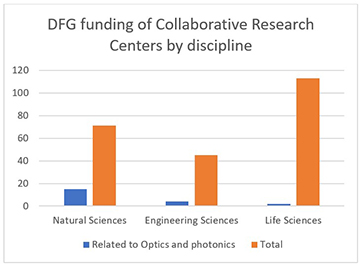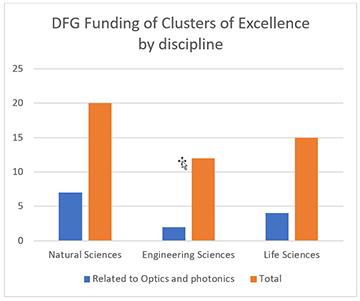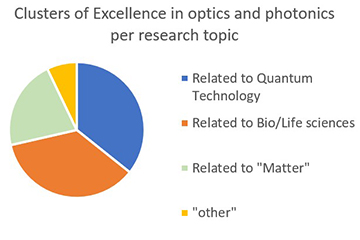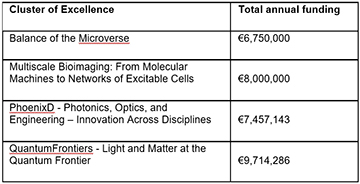![]()
[Image: peterschreiber.media/Getty Images]
This is the second article in a series describing public research funding in Germany. Claus Roll is a director of research and program development for OSA Europe.
In a recent article, we offered an overview of the general funding schemes in Germany, the European Union’s largest economy. We noted there that areas explicitly described as “optical technologies” received a total of €245.8 million of public funding in 2020—but that the total funding for optics and photonics is likely much larger, with much of it “hidden” in other domains like electronic systems, microsystems, nanotechnology and materials technologies.
The remaining articles in this series will drill down into funding via specific channels and agencies within that overall picture. In this story, we look at optics and photonics funding by the German Research Foundation (Deutsche Forschungsgemeinschaft, or DFG)—an independent research-funding organization serving all branches of science and the humanities at universities and non-university research institutions.
While DFG operates independently, its actual annual budget of approximately €3.3 billion (as of 2020) is provided by the German federal government (58%) and state governments (42%). The Foundation doesn’t track just how much of that budget goes to optics and photonics—partly, perhaps, owing to these subjects’ interdisciplinary nature—and its explicit classifications do not allow easy identification of funding in this domain. Nevertheless, by mining the DFG website, it is possible to begin inferring the proportion of DFG funding that supports work in optics and photonics.
Centers and Clusters
Two examples of specific DFG funding instruments—Collaborative Research Centers (CRCs) and Clusters of Excellence—offer a glimpse of how at least some information on optics and photonics funding can be “backed out” of project descriptions and funding levels.
Collaborative Research Centers. CRCs aim to provide long-term support (up to three four-year periods of funding) for outstanding institutes from different disciplines at universities. In 2020, CRCs accounted for €796.7 million of DFG’s €3.3 billion in total funding.
Our research suggests that, of the 264 funded CRCs as of 2020 across all disciplines, 21 are linked to or involve research in optics and photonics. These fall entirely within the 229 CRCs listed under the headings Natural Sciences, Engineering Sciences and Life Sciences. Different CRCs may be in different stages of progress, and in their first, second or third (last) round of funding.
To determine the annual funding (as shown in the accompanying graph), the total amount allocated to each project is divided by the four-year funding period. That implies annual funding provided to these 21 optics-and-photonics-related CRCs of approximately €51 million, or an average of roughly €2.5 million each.
Clusters of Excellence. These clusters, another instrument for DFG financial support, target long-term funding (seven-year periods) for research at the highest international levels—to establish Germany as a player within the international scientific competition. In 2020, the total annual budget of all clusters amounted to €385 million.
Our detailed investigation indicates that of the 57 DFG Clusters of Excellence funded as of last year, 14 are carrying out research involving optics and photonics, again distributed across the Natural Sciences, Engineering Sciences and Life Sciences divisions. As of 2020, those 14 clusters received annual DFG funding of €99.5 million (the annual number representing one-seventh of the total funding across the seven-year commitment for this funding instrument).
Getting at the optics-and-photonics role
These calculations provide a general idea of the magnitude of projects in these programs that involve optics and photonics in some way. But the devil is, as usual, in the details—can we infer the scope of optics and photonics funding more precisely?
The difficulty in doing so is revealed by digging a bit deeper into the Clusters of Excellence. By design, the clusters focus particularly on interdisciplinary approaches, whether by combining different topics within physics only, or via a much wider approach involving contributions from physics, chemistry, biology, medicine, and more. The 14 clusters with some research contribution from optics and photonics are distributed broadly among the areas of quantum technology, bio/life sciences, “matter”-related topics, and other categories.
The different levels of interdisciplinarity emerge from a closer look at four specific clusters:
Balance of the Microverse (Jena). This cluster draws from chemistry, medicine, life science and physics, including optics and photonics. Specific optics-related work includes the use of bioimaging and biomedical-imaging technologies at high spatiotemporal resolution, as well as methods development involving interaction between experts in optics and life sciences.
Multiscale Bioimaging (Göttingen). This cluster combines work in medicine, life sciences and biophysics. Teams in optical nanophysics, nano-biophotonics, nano-optics and ultrafast dynamics contribute to the main research areas, together with other teams from various disciplines in life sciences and medicine.
Photonics, Optics and Engineering—Innovation Across Disciplines (coordinated by the Gottfried Wilhelm Leibniz University of Hannover). Here, the interdisciplinary scope is much narrower, and all research areas cover optics issues.
QuantumFrontiers—Light and Matter at the Quantum Frontier (coordinated by the Gottfried Wilhelm Leibniz University of Hannover and the Technical University of Braunschweig). Again, interdisciplinary breadth is much narrower, and optics and photonics contributes a large percentage.
These four examples illustrate the difficulty of calculating the precise amount of DFG funding that supports research in optics and photonics—as the only available figures are those for the Clusters of Excellence as a whole.
A partial picture—again
As in the first article of this series, which covered German government funding generally, it’s not possible to come up with a precise number for the share of DFG funding that goes to optics and photonics. What can be said instead is that, if the CRC and Clusters of Excellence instruments are combined, DFG is annually investing roughly €150 million per year in projects that involve optics and photonics in some way. That, in turn, amounts to around 12% of the €1.182 billion that DFG invests overall through these two research-funding instruments.
This provides, then, only a partial picture—and overestimates, by an unknown amount, the proportion that optics and photonics represent in DFG research funding through these instruments. Still, it does offer an upper limit, and shows these fields’ importance as an interdisciplinary contributor in numerous research contexts.
In future stories in this series, Claus Roll will explore optics and photonics funding by the German Federal Ministry of Research and Education, as well as the situation of optics and photonics research in the country’s extensive network of public–private research institutes—particularly in the Fraunhofer Institutes.




